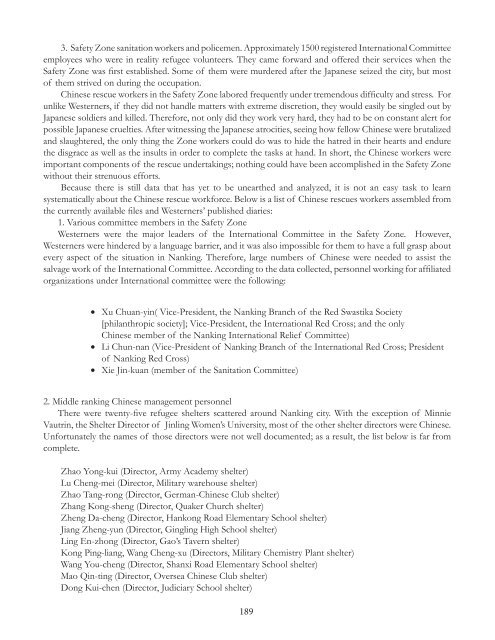Download - Canada ALPHA
Download - Canada ALPHA
Download - Canada ALPHA
Create successful ePaper yourself
Turn your PDF publications into a flip-book with our unique Google optimized e-Paper software.
3. Safety Zone sanitation workers and policemen. Approximately 1500 registered International Committee<br />
employees who were in reality refugee volunteers. They came forward and offered their services when the<br />
Safety Zone was fi rst established. Some of them were murdered after the Japanese seized the city, but most<br />
of them strived on during the occupation.<br />
Chinese rescue workers in the Safety Zone labored frequently under tremendous diffi culty and stress. For<br />
unlike Westerners, if they did not handle matters with extreme discretion, they would easily be singled out by<br />
Japanese soldiers and killed. Therefore, not only did they work very hard, they had to be on constant alert for<br />
possible Japanese cruelties. After witnessing the Japanese atrocities, seeing how fellow Chinese were brutalized<br />
and slaughtered, the only thing the Zone workers could do was to hide the hatred in their hearts and endure<br />
the disgrace as well as the insults in order to complete the tasks at hand. In short, the Chinese workers were<br />
important components of the rescue undertakings; nothing could have been accomplished in the Safety Zone<br />
without their strenuous efforts.<br />
Because there is still data that has yet to be unearthed and analyzed, it is not an easy task to learn<br />
systematically about the Chinese rescue workforce. Below is a list of Chinese rescues workers assembled from<br />
the currently available fi les and Westerners’ published diaries:<br />
1. Various committee members in the Safety Zone<br />
Westerners were the major leaders of the International Committee in the Safety Zone. However,<br />
Westerners were hindered by a language barrier, and it was also impossible for them to have a full grasp about<br />
every aspect of the situation in Nanking. Therefore, large numbers of Chinese were needed to assist the<br />
salvage work of the International Committee. According to the data collected, personnel working for affi liated<br />
organizations under International committee were the following:<br />
• Xu Chuan-yin( Vice-President, the Nanking Branch of the Red Swastika Society<br />
[philanthropic society]; Vice-President, the International Red Cross; and the only<br />
Chinese member of the Nanking International Relief Committee)<br />
• Li Chun-nan (Vice-President of Nanking Branch of the International Red Cross; President<br />
of Nanking Red Cross)<br />
• Xie Jin-kuan (member of the Sanitation Committee)<br />
2. Middle ranking Chinese management personnel<br />
There were twenty-fi ve refugee shelters scattered around Nanking city. With the exception of Minnie<br />
Vautrin, the Shelter Director of Jinling Women’s University, most of the other shelter directors were Chinese.<br />
Unfortunately the names of those directors were not well documented; as a result, the list below is far from<br />
complete.<br />
Zhao Yong-kui (Director, Army Academy shelter)<br />
Lu Cheng-mei (Director, Military warehouse shelter)<br />
Zhao Tang-rong (Director, German-Chinese Club shelter)<br />
Zhang Kong-sheng (Director, Quaker Church shelter)<br />
Zheng Da-cheng (Director, Hankong Road Elementary School shelter)<br />
Jiang Zheng-yun (Director, Gingling High School shelter)<br />
Ling En-zhong (Director, Gao’s Tavern shelter)<br />
Kong Ping-liang, Wang Cheng-xu (Directors, Military Chemistry Plant shelter)<br />
Wang You-cheng (Director, Shanxi Road Elementary School shelter)<br />
Mao Qin-ting (Director, Oversea Chinese Club shelter)<br />
Dong Kui-chen (Director, Judiciary School shelter)<br />
189


